| The Crime Dossiers of Dennis Wheatley and J G Links |
The four crime dossiers devised by Dennis Wheatley and J.G. Links in the 1930s were a completely original venture and, at least initially, immensely popular both in Britain and around the world. Although there had been 'solve it yourself' crime books in the past, such as the 'Baffle Books' created by Lassiter Wren and Randle McKay, Wheatley and Links were to take the format one or more steps further.
What makes the crime dossiers so unique was that they presented the reader with all the evidence that an investigating team of detectives might gather and then ask him/her to solve the crime. To this end, a variety of physical clues and reports were housed together in a cardboard folder, which if worked through methodically as any detective might, would yield the correct solution to the problem. Having used deduction to arrive at a prime suspect, the reader could then check his findings with the actual solution to the mystery that was concealed within a sealed section towards the rear of the folder.
The physical clues in all four of the dossiers included both real items such as cigarette ends, curls of hair, bloodstained material, 'poison' pills, scene of crime photographs etc. and clever facsimiles of spoof cablegrams, reports, interviews with suspects, handwritten letters and newspaper cuttings. The very complex mysteries presented, required the reader to be a fully engaged and active participant in the investigation rather than merely absorbing a story in a largely passive way as with most detective fiction. There is no narrative as such, the reader provides that himself, by assimilating the facts and assessing the evidence surrounding the case. The result is therefore a curious cross between a work of fiction to be read and a game to be played.
Reg Gadney, in his article 'The Murder Dossiers of Dennis Wheatley and J.G. Links' that appeared in the London Magazine in March 1969, drew parallels between the avant-garde nature of the dossiers and Marcel Duchamp's 'Readymades'. In the case of Duchamp, his real objects, urinal, bicycle wheel, snow shovel etc., were presented as complete object d'art but, because of their mass-produced nature, they challenged the very meaning of art itself by requiring the viewer to construct his own aesthetic. In a similar way the dossiers challenged the meaning of fiction in that they presented the scene of crime material and various facts about the case and left the reader to construct the story. But whereas Duchamp's conceptual work was to have a profound effect on the subsequent development of western art, the dossiers of Wheatley and Links, were, in the eyes of some a cul-de-sac, and traditional crime fiction is as strong today as it was before their appearance.
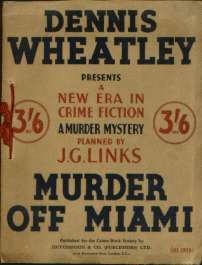 |
| Hutchinson, London 23 July 1936 N.B. 1st Editions have no date, later impressions show 'nth Thousand' on cover |
The first dossier, 'Murder Off Miami', was published by Hutchinson on July 23rd. 1936 and priced at 3/6. At this price, profit margins were very tight as the production costs, which involved sticking all the physical clues and sheets of written evidence in place manually, were high. Walter Hutchinson agreed to pay a royalty of just one penny each to Wheatley and Links on any sales in excess of 10,000. However, at the outset, the idea might have been stillborn, as the reaction of bookstall and bookshop managers was largely negative. The thin card covers made them difficult to display and it was felt that they were too innovative for general consumption. However, Wheatley believed in them wholeheartedly, and having wined and dined dozens of such managers across London, convinced them to take a small number. Selfridges were more forthcoming, agreeing to take 1,000 copies, as long as Wheatley signed each one, which he gladly did.
In the event, the response of the public and press was very positive and Wheatley states in the third volume of his autobiography, 'Drink and Ink', that 120,000 copies were sold in six months. He added that Queen Mary bought all six copies held by Hatchards, on the day of publication.
 |
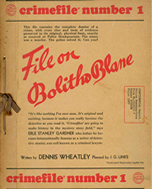 |
| Wm. Morrow, New York 1936 |
Wm. Morrow, New York 1936 (Hardback version) |
Publishers around the world seized upon the novelty. In America, William Morrow published 'Murder Off Miami' as 'Crimefile Number 1 File on Bolitho Blane', producing both hardback and soft cover versions. Morrow also published 'Crimefile Number 2 File on Rufus Ray' by the prolific American crime writer Helen Reilly, and Q. Patrick's 'Crimefile Number 3 File on Fenton and Farr' and 'Crimefile Number 4 File on Claudia Cragge', which are the best of a small number of imitations of Wheatley and Link's original idea.
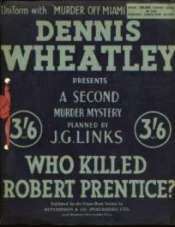 |
| Hutchinson, London 1st June 1937 |
The second dossier, 'Who Killed Robert Prentice?' (1937), a more complex and intriguing mystery than the first, enjoyed a similar success, and was published in the United States by Greenberg as 'File on Robert Prentice' making it uniform with the four Morrow crime files. Contained in this dossier is a spoof newspaper, the 'South Sussex Chronicle' in which there is an interview with Mr. and Mrs. Wheatley and J.G. Links. After a long discourse on Wheatley's phenomenal success as a writer, the three give their guarded views on the outcome of the murder case.
 |
| Hutchinson, London 1st April 1938 |
However, by the time the two friends had reached their third dossier, 'The Malinsay Massacre' (1938), they were perhaps running out of steam. Here, the physical clues are cut down to a minimum, and much reliance is placed on newspaper cuttings and printed matter. The only 'real' item of evidence is one of the 'poison' tablets containing arsenic sent to Colin Raeburn. Beneath this is the amusing message: 'Note to readers: The poison has been extracted from this tablet'. Whether this was added for health and safety reasons or to warn would-be murderers not to bother using it is not clear! The key to the mystery is virtually on the first page, but one might wonder if many readers noticed it, and it's conceivable that some would-be detectives tore open the sealed solution, having failed to solve the murder. Wheatley and Links also fell out briefly over the photographs for this dossier. Having written the story, Wheatley went on holiday, leaving Links to arrange the photography. Although the mystery is set in an ancient Scottish castle, Links allowed the photographs to be taken in the Carlton Hotel in London. On his return, Wheatley considered the photographs were inappropriate, but by then it was too late to do anything about it.
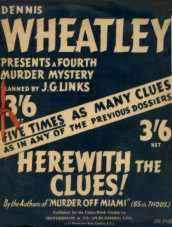 |
| Hutchinson, London 27 July 1939 |
The fourth dossier, 'Herewith the Clues' was published in July 1939, and was to be the last. Wheatley and Links toyed for a while with the idea of presenting this mystery in a box rather than a folder. However, this was soon abandoned when they discovered that presented in this way, it would find itself placed in the games section of shops rather than onto the bookshelves. Production costs had also risen, and although this dossier included sixteen physical clues, they were all stuck down onto a single page rather than distributed throughout the text, as was the custom previously. Another difference was that this time Wheatley got some of his celebrity friends to pose for the photographs, giving both their fictional names and their real names under the illustrations.
A page in Wheatley's unpublished memoirs reveals that a fifth dossier was planned, with the working title 'Murder in New York', but the war intervened and it never reached the production stage.
During the Second World War, the production material for the Murder Dossiers was destroyed during the blitz over Plymouth alongside the type for Wheatley's more conventional novels, and owing to the enormously increased costs of dossier production, the Murder Dossiers were not to be re-published for some forty years.
An amusing anecdote related by Wheatley in his autobiography, recounts an occasion when the publicity conscious Billy Butlin, approached him with the idea of using one of his holiday camps as a setting for another dossier. However, Wheatley felt that he could 'not see such characters as Sir Pellinore Gwaine-Cust or the Princess Marie-Lou disporting themselves in a Butlins Holiday Camp', and one can only guess with what tact he declined this lucrative offer. Frank Richards must have received a similar approach, but unlike Wheatley, accepted and readily packed Billy Bunter off to Butlins!
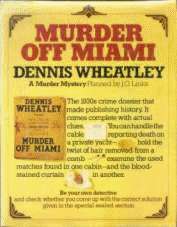 |
| Hutchinson : Webb & Bower 1979 |
In 1979, Hutchinson reissued 'Murder off Miami' as a 'facsimile' of the 1936 edition. Costly to produce, and this time placed inside a colourful dust wrapper, it was not an exact copy. The covers were slightly shorter and the words: 'Published for the Crime-Book Society by Hutchinson and Co. (Publishers) Ltd.', that appear on the early editions were omitted. Nevertheless, it was close enough to the original to have caused confusion among booksellers ever since!
Martin Wainwright, in his Guardian Diary on 11th. May 1979, wrote:
"Nuns from convents all over Europe provided the vital twists of hair for the new editions (the sample the detective finds is a mixture of gold strands and black).
The used matches which play a part in the affair kept the printers busy after work, when their staff each took home several books and patiently struck their contents. Finally, a special chemical mixture provided a lasting bloodstain on the piece of curtain glued in each book, after the real blood donated by a director of the printing firm faded almost at once."
 |
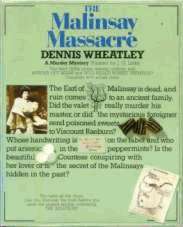 |
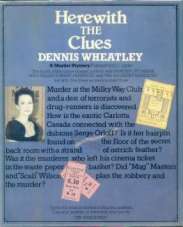 |
| Webb & Bower 1980 |
Webb & Bower 1981 |
Webb & Bower 1982 |
The remaining dossiers were published in facsimile over the next three years, ending with 'Herewith the Clues' in 1982, and although this was considered to be the weakest of the four dossiers on its initial publication, its facsimile was received enthusiastically.
Graham Lord, writing in the 'New Books' section of the Sunday Express on 28th. March 1982, said this:
"Few books can be guaranteed to give hours of fun to everyone from the age of about ten upwards.
… More a game than a book and certainly not a novel despite being fictional, it is a baffling superbly produced murder mystery dossier tied with red-ribbon and complete with clues you can actually handle and evaluate (like real cigarette ends and a lock of hair) to come up with the identity of the murderer.
… The whole concoction is the fourth and last lovingly faithful modern reprint of a series of dossiers devised by Wheatley and Links in the 1930s which sold then by the hundred thousand and which even now, resurrected, have sold a quarter of a million copies world-wide.
… Whodunit fans will find it great fun and the book would be an intriguingly unusual present for any who enjoy racking their brains."
It is worth reflecting on the fact that the references to the I.R.A. in the storyline of this dossier had a far greater resonance for the people of Britain in 1982 than in 1939!
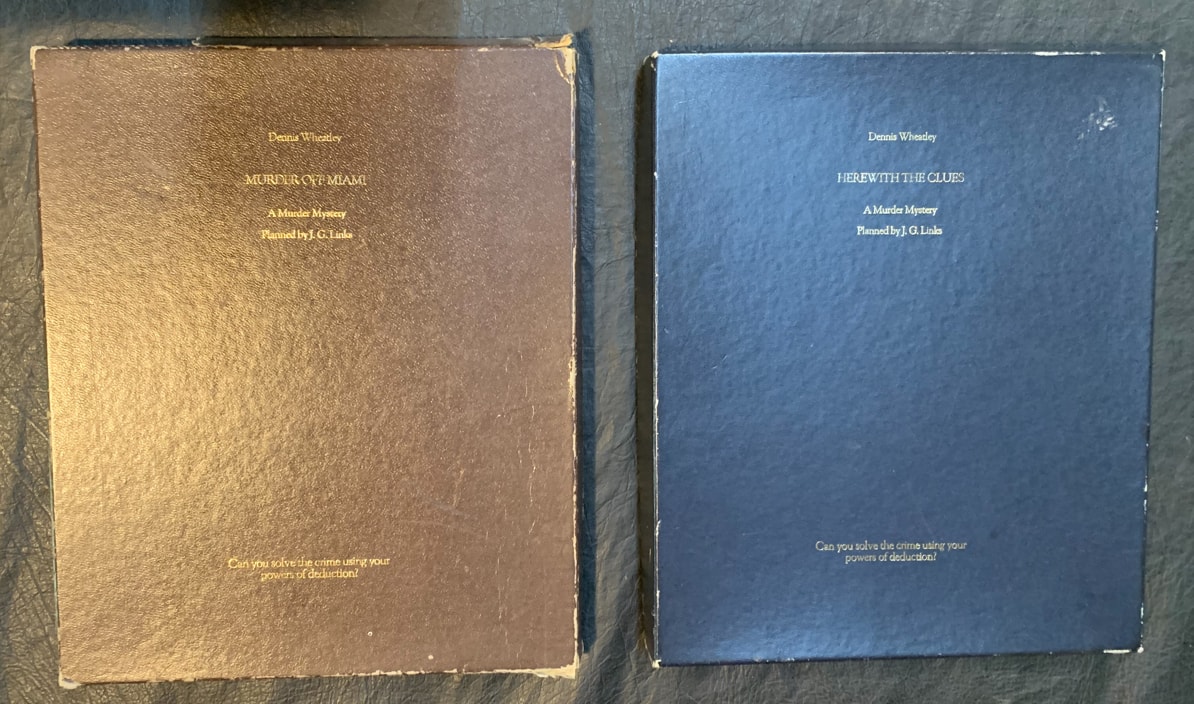
A 1981 copy of 'Murder Off Miami' and a 1982 copy of 'Herewith the Clues' in protective boxes instead of the 1980s shiny wrappers. Possibly they were trial pieces. Their exact status remains unknown.
The dossiers made another appearance in 1986, when Webb and Bower in conjunction with Michael Joseph, published them in glossy hardback editions. This time, however, all the physical clues, the very point of the dossiers' original novelty, were reduced to photographs and the venture was a failure.
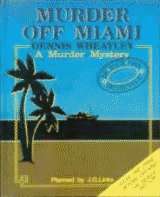 |
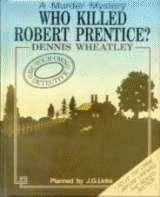 |
 |
 |
| Webb & Bower (in association with Michael Joseph) 1986 |
Webb & Bower (in association with Michael Joseph) 1986 |
Webb & Bower (in association with Michael Joseph) 1986 |
Webb & Bower (in association with Michael Joseph) 1986 |
Moving on, in the late 1980s and early 1990s, some of the dossiers were produced as computer games..
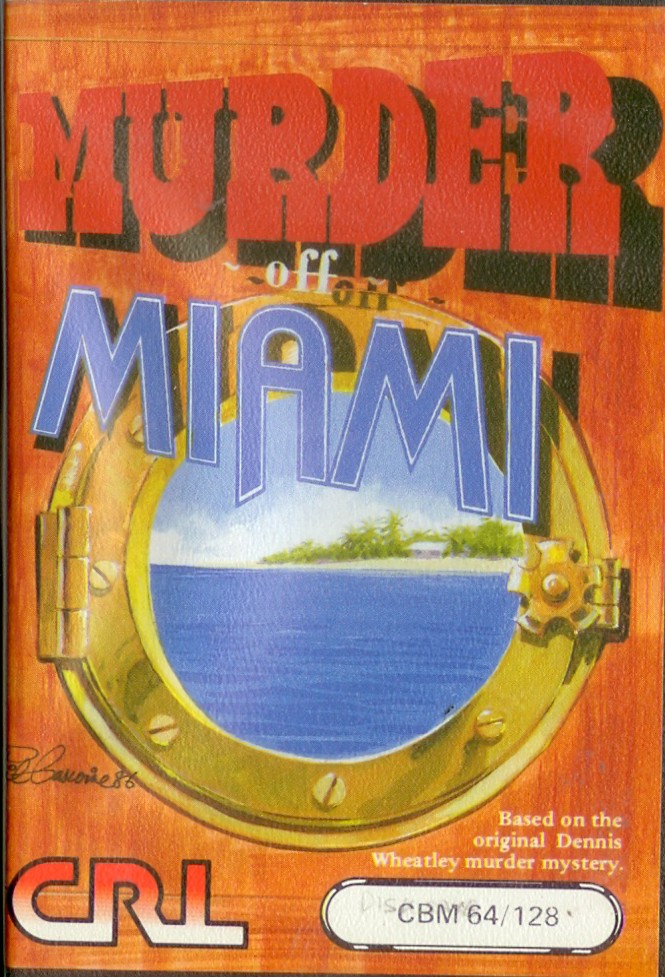 |
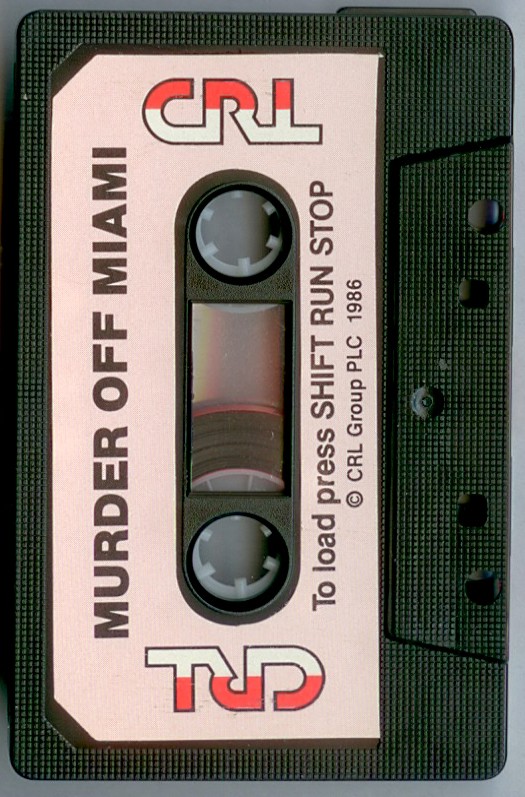 |
 |
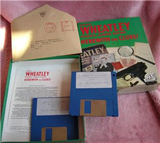 |
When the dossiers were published in Germany in the 1930s, only three were initially given the green light by the Nazi Chamber of Literature and the Ministry of Propaganda. 'Who Killed Robert Prentice' was castigated on the grounds that the main protagonist, Cicely Prentice, was a woman whose 'moral character must be designated more than inferior'. Such a clever and manipulative female offended the Nazi ideal of the passive, obsequious hausfrau, and one of the clues, the torn up photograph of a naked woman, would have fallen foul of the rigid Nazi censorship laws.Because of this, for a long time the received wisdom was that 'Who Killed Robert Prentice' was never published in pre-war Germany. Recently however a pre-war German copy has come to light, proving this inaccurate. When the dossiers were reissued in Germany in the mid 1980s, for reasons unknown, 'Herewith the Clues' was omitted.
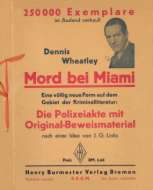 |
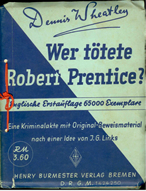 |
| Murder off Miami Henry Burmester Verlag Bremen 1937 |
Who Killed Robert Prentice Henry Burmester Verlag Bremen n d |
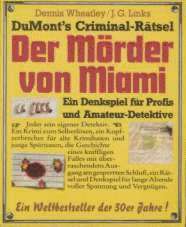 |
 |
 |
| DuMont Verlag, Köln 1983 |
DuMont Verlag, Köln 1984 |
DuMont Verlag, Köln 1983 |
| Literal translation - 'The Murderer Of Miami' |
Literal translation - 'The Murder In The Country House' |
Literal translation - 'The Secret Around Castle Malinsay' |
In the early 1980s, dossiers were published in both the United States and Britain that took the cases of Sherlock Holmes as their inspiration. Clearly based upon Wheatley and Links' original idea, they were edited by Simon Goodenough, and composed of physical clues and documents held within card covers tied with ribbon. I am aware of three such dossiers: 'A Study in Scarlet', 'The Sign of Four' and 'The Hound of the Baskervilles'.
The original crime dossiers quickly became collectors’ items, and for a while, achieved higher prices than any other of Wheatley’s books. But with his waning popularity, in recent years their value has dropped and decent copies with the seal broken can be picked up now for between £20-£60. The few copies that have survived intact are worth looking for, but are naturally much more expensive, costing well over £100, signed copies with the seal intact, even more.
On the back cover of the first printing of 'Murder Off Miami' Wheatley included the following legend:
Keep this carefully
It is a First Edition of the first Crime Story ever
presented in this way. Should others follow, it is
possible that an undamaged copy of "Murder off Miami"
may be of considerable interest one day
He was right!
This page last updated Copyright © 2002-2006 Bob Rothwell. 2007-2025 Charles Beck. Article Copyright © Richard Humphreys 2002. Minor updates made by Charles Beck 2024.